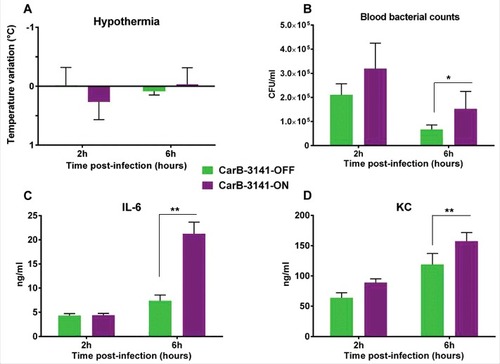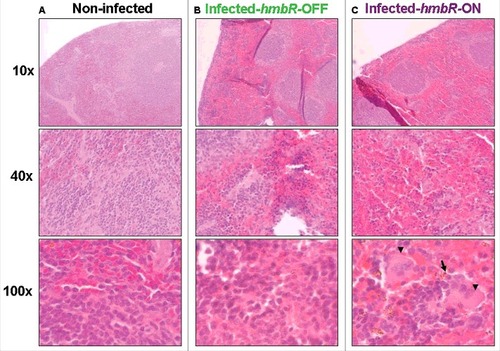Figures & data
Table 1. Characteristics of the isolates used in this study.
Figure 1. Phylogenetic trees comparing the two reference strains (MC58 and H44/76) with the six isolates from the clonal Norman outbreak: two capsulated isolates from invasive disease (InvB-1483 and InvB-2018), two capsulated isolates from asymptomatic carriage (CarB-3141 and CarB-3644) and two non-groupable (i.e., non-capsulated) isolates from asymptomatic carriage (CarNG-1126 and CarNG-2963); (A) global analysis based on whole genomic single-nucleotide polymorphisms; (B) gene-by-gene analysis based on the 1605 genes of core genome MLST; (C) gene-by-gene analysis based on 102 genes involved in meningococcal virulence (capsule genes, iron acquisition genes (hpuAB, hmbR, fetA, tbpAB and lbpAB) and Maf toxin/anti-toxin system) that were selected from the drop menu on the scheme box on the PUBMLST.org.

Figure 2. Ability or not of isolates from the clonal Norman outbreak to grow on iron depleted plate around disk impregnated with human (Hhb) or murine (Mhb) hemoglobin; (A) growth of two capsulated isolates from invasive disease (InvB-1483 and InvB-2018); (B) no growth of two capsulated isolates from asymptomatic carriage (CarB-3141 and CarB-3644); (C) growth of “ON” phase variants of the two previous carriage isolates (CarB-3141-ON and CarB-3644-ON) selected to express the hemoglobin receptor protein (HmbR).

Figure 3. Comparative virulence in transgenic mice of wild-type capsulated isolates from asymptomatic carriage (CarB-3141 and CarB-3644) and their phase variants able to expresses the HmbR receptor protein (CarB-3141-ON and CarB-3644-ON); (A) kinetic of hypothermia post infection (i.e., symptom of infection); (B) blood bacterial counts; (C and D) levels of inflammatory cytokine IL-6 (C) and KC (D). Each point represents the mean of values achieved in 6 animals for each isolate of the given group. (#p < 0.05 and ##p < 0.005).

Figure 4. Spleen histopathology at different magnifications in transgenic mice either: (A) non-infected (negative control), (B) infected by the wild-type capsulated carriage isolate (CarB-3141-OFF) unable to express HmbR or (C) infected by the phase variant capsulated carriage isolate (CarB-3141-ON) able to express HmbR. Bacteria (arrow) and macrophages (arrow heads) are visible only for this later isolate. Presented data are typical representative pictures of three repeats for each of the two isogenic isolates (CarB-3141-OFF and CarB-3141-ON).

